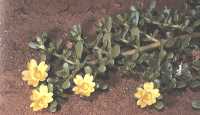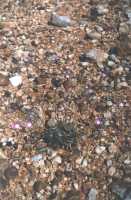
Wakati - Pig Weed
photo Tim Low
Wakati,
the Pigweed (Portulaca
oleracea) is a common fleshy groundcover with small yellow flowers and
small black seeds. It can be found in sandhill and breakaway country, and is most prolific
after rain.
The seed, although small, is a very
important food source. Whole plants can be gathered up when the seed has set and piled
together for several days until all the seed has fallen to the ground. The plant displays
the time when it should be collected by changing the colour of its stems from green to
pink. Up to 10000 seeds can be produced on each plant. These are harvested from beneath
the pile of plants, cleaned and either roasted before being ground into a paste, or cooked
after grinding. Cakes of this paste are baked in hot sand with ashes and coals. Wakati
seed is very nutritious, being 28% protein and 16% fat, with a high concentration of
vitamin E.
The leaves and stems of this plant are also
edible raw or cooked, and the cooked roots can be eaten.
Nyurngi
Calandrinia spp.
Parakeelya

Nyurngi - Parakeelya
A similar small succulent herb, the Nyurngi (Parakeelya)
(Calandrinia spp.), also has
edible seed, however, these are only used in times of hardship as the seed only ripen
gradually, so little seed can be collected at any one time. During emergencies, the leaves
and stems can be eaten raw to obtain moisture. |